Here in Australia, barbecue season has begun.
In Sydney, there was masses of rain shortly after the autumn holidays, and I let my courtyard and garden go ratso. While the boys were away with their mother over winter, I went on the attack (along with a tradie with a high pressure hose), and reclaimed this important out-door space, ready for barbecues and the planting of yummy things!
Thursday night was the sixth and final spring holiday night with my boys, and this was capped off when my grownup niece and her partner came over for dinner and a movie.
Barbecue steak, veggies, green beans and couscous. But it’s not this, it’s tonight’s bachelor version I’m dealing with here.
The salad
For the Thursday night, I combined couscous (in vegetable stock) with browned slivered almonds, a barbecued tomato, chopped, and sliced tender green beans. But I held something in reserve (well, I forgot to add it, but it comes to the same thing): dried cranberries.
The sauce
Parsley, shallots, oregano, one clove garlic - chop finely, or pound in a mortar. Chilli oil and olive oil.
And now for the skirt
When thinking of the ideal barbecue cut, most people think porterhouse or t-bone, that sort of thing. But cheaper and better is skirt. You just have to treat it right.
I see skirt in the butcher most often rolled in cling wrap ready for roasting. But it is also one of the most flavourful cuts for the grill. It also accepts a marinade very well. And it is about half the price of porterhouse.
The key is: cut across the grain.
Unroll the skirt roast, and cut into steaks along the grain.
On a hot barbecue grill, cook three minutes, then turn once, cooking for another three minutes.
Remove to rest on a cutting board, then slice down at a 45 degree angle and across the grain. It will be as tender and juicy as a prime cut, but with much more flavour.
The steak pictured (top) was cooked a little too long (more like four min each side) (I got distracted) and left to rest for not long enough (I was hungry) - so it’s not pink enough and too much juice is on the outside. But it was still very, very soft and yummy.
And the combo
Warming the green salsa and the couscous salad and layering with the freshly barbecued skirt over a warmed, soft corn tortilla - well, it was warming.






